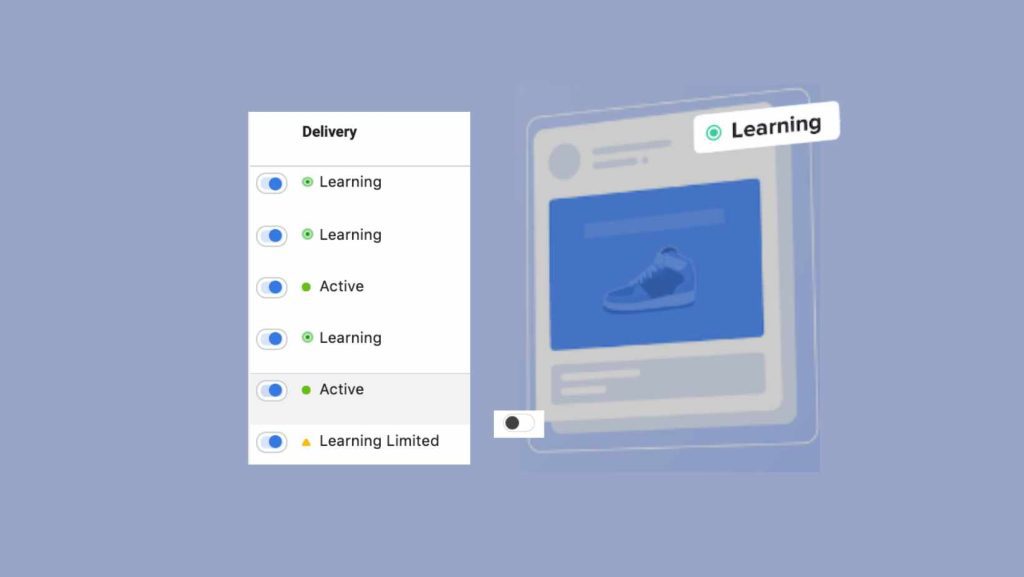I. Introduction
With the dominance of social media in today’s digital marketing landscape, Facebook Ads have become an integral part of successful online advertising campaigns. But to fully harness the potential of Facebook Ads, you need to understand the intricacies of the platform, including a key concept called the Facebook Ads learning phase.
II. Understanding the Facebook Ads Learning Phase

The learning phase Facebook introduced is an automatic process that takes place when you launch a new ad or ad set. During this time, Facebook’s algorithm is busy learning about your ad, trying to figure out the best way to deliver it to your target audience.
Typically, the learning phase lasts for about seven days but can vary depending on your ad’s performance and changes made during this phase. It’s critical because it helps Facebook optimize your ad for better results over time.
III. Navigating the Facebook Ads Learning Phase
You can identify when an ad is in the Facebook learning phase by checking the delivery column of your Ads Manager. Ads will exit this phase when they have accumulated sufficient impressions to allow Facebook’s algorithms to understand and optimize their delivery effectively.
Understanding the behavior of your ads during this learning phase is crucial. Typically, an ad’s performance can be volatile during this time, but don’t worry – this fluctuation is a normal part of the process.
IV. Strategies for Mastering the Ads Learning Phase
To truly excel in your Facebook advertising efforts, understanding the ins and outs of the learning phase Facebook Ads undergo is crucial. Let’s delve deeper into strategic approaches that can help you master this phase and optimize your campaigns for improved performance.
Creating Relevant and Engaging Ads
The relevance and engagement level of your ads plays a significant role in their success. High-quality and engaging content increases the likelihood of your audience interacting with your ads, which in turn sends positive signals to Facebook’s algorithms about your ad’s performance. The quicker your ad shows favorable results, the quicker it can exit the learning phase. To ensure your ads are engaging:
- Understand your audience’s needs, wants, and pain points. Craft your message in a way that resonates with them and highlights the value your product or service can provide.
- Use high-quality, eye-catching visuals to grab attention. In an environment where users scroll through numerous posts, standing out visually can make a difference.
- Employ clear and compelling calls to action (CTA) that motivate users to engage with your ad.
Budget and Bid Strategy Management
Your ad budget and bid strategy significantly influence the duration and outcome of the learning phase. A budget that’s too low can cause the learning phase to prolong, as it may not allow for enough impressions for the algorithm to learn effectively. Conversely, an overly aggressive bid strategy may lead to high initial costs and can also limit your ad’s reach. Thus:
- Set a realistic daily or lifetime budget that allows your ad to get enough impressions.
- Choose the right bidding strategy that aligns with your campaign objective. If you’re new to Facebook Ads, you may want to start with lowest cost bidding and then experiment with other strategies as you gain more experience.
Precise Audience Targeting
Identifying and targeting the right audience is vital right from the get-go. If your target audience is too broad, your ad may struggle to perform well because it lacks focus. Conversely, a too narrow audience may limit the number of impressions your ad can get, which can also extend the learning phase. It’s crucial to strike a balance:
- Spend time researching and understanding your ideal customer profile. Use Facebook’s detailed targeting options to reach your desired audience effectively.
- Test different audience segments to find out which respond best to your ads. Remember, each time you test a new audience, your ad will go through the learning phase again, so plan your budget and timeline accordingly.
These strategies form the cornerstone of mastering the learning phase Facebook Ads initiate. By implementing these best practices, you can shorten the learning phase and set your ads up for long-term success.
V. Best Practices During the Facebook Ads Learning Phase
Understanding the mechanics of the learning phase Facebook applies to your ads is one thing, but knowing how to behave during this phase to maximize your ads’ performance is another. Here are some essential practices to consider for effectively navigating this crucial phase in your Facebook advertising journey.
Avoiding Major Edits
One of the best practices during the learning phase is to avoid making substantial edits to your ad sets. Major changes, such as significantly modifying your target audience, altering your ad creative, or adjusting your budget considerably, will restart the learning phase. This means Facebook’s algorithm will need more time to understand and optimize your ad set, which may delay you in achieving your desired results.
Therefore, before you launch your ad set, ensure that all aspects, from creative to targeting, are as you want them. If you’re not sure about certain components, consider running separate ad sets to test them, instead of editing an existing one.
Patience is Key
During the learning phase, it can be tempting to make quick adjustments in response to early performance data. However, this period is marked by performance fluctuations as the algorithm is still gathering data and optimizing the ad delivery. So, it’s generally best to wait until the learning phase is complete before making decisions about your ad set’s performance.
In other words, patience plays a significant role in the success of your Facebook Ads. Don’t rush to conclusions based on the performance of your ads during the early learning phase. Remember that it takes time for the algorithm to understand the best way to deliver your ads.
Monitoring Performance Metrics
While it’s important to avoid rash decisions based on early performance data, you should still keep a close eye on your metrics during the learning phase. Understanding how your ads are performing can give you insights into potential issues that may need to be addressed after the learning phase.
Monitoring performance metrics like click-through rate (CTR), conversion rate, cost per action (CPA), and return on ad spend (ROAS) can help you gauge whether your ad is on track to meet your goals. Remember to look at these metrics holistically rather than in isolation to gain a more accurate understanding of your ad’s performance.
In summary, the best practices for navigating the Facebook learning phase involve minimizing edits, exhibiting patience, and monitoring performance metrics closely. By adhering to these guidelines, you can allow the learning phase to complete its course effectively and set your Facebook Ads on a trajectory towards success.
VI. Case Study: Success Stories with Facebook Ads Learning Phase
Case Background: HealthyBites – A Fitness Meal Subscription Service
HealthyBites is a thriving fitness meal subscription service that had successfully harnessed the power of social media, particularly Facebook Ads. Their aim was to drive more subscriptions and increase brand awareness. Despite having some success with their Facebook campaigns, they wanted to optimize their performance and ROI. Upon delving deeper into Facebook Ads mechanics, they realized the potential of fully utilizing the Facebook Ads learning phase.
Strategy: Understanding and Implementing the Facebook Ads Learning Phase
HealthyBites decided to focus on mastering the learning phase Facebook Ads undergo when a new campaign is launched. They began by crafting more engaging ads, focusing on high-quality images of their meal options, and compelling ad copy that highlighted the convenience and health benefits of their service.
Next, they refined their audience targeting. Using data from their existing customers, they defined their audience as fitness enthusiasts aged 20-35, with interests in healthy eating, fitness routines, and meal planning. They also targeted users who had interacted with their Facebook page and visited their website.
Finally, they decided to let the algorithm fully learn, resisting the urge to make significant changes during the learning phase, and giving it ample time to optimize the ad’s delivery.
Results: Improved Performance and Increased ROI
With these strategies in place, HealthyBites ran their campaigns and allowed the Facebook learning phase to complete. They noticed that the performance metrics initially fluctuated, but as the learning phase completed, they started seeing improved consistency and overall performance.
The Cost Per Action (CPA) began to decrease, and the engagement rate increased, indicating that their ads were resonating with their target audience. Most importantly, the Return on Ad Spend (ROAS) saw a significant rise. HealthyBites had more subscribers signing up through their Facebook Ads than before, leading to a direct increase in their revenue.
In just a few months, HealthyBites witnessed a 30% reduction in their CPA, a 20% increase in their ad engagement rate, and a 25% increase in their ROAS.
HealthyBites’ success story illustrates the significant impact understanding and correctly utilizing the Facebook Ads learning phase can have on a business’s digital marketing efforts. By crafting engaging ads, defining their audience accurately, and allowing the algorithm to fully learn, they managed to lower their costs, increase engagement, and significantly boost their return on ad spend. Their story serves as an inspiration for other businesses to leverage the learning phase in their Facebook Ads strategy.
VII. Advanced Strategies for Ads Learning Phase
Advanced strategies like split testing and dynamic creative can further enhance the results from your Facebook ads.
Split testing allows you to test different variables and see which works best, while dynamic creative automatically tests different combinations of your ad components to find the best performance.
One key challenge here is scaling your ads without disrupting the learning phase. Scaling needs to be done gradually, ensuring you don’t trigger a reset of the learning phase.
VIII. Common Pitfalls and How to Avoid Them
One of the common pitfalls is over-editing ads during the learning phase, which as mentioned earlier, resets the learning phase.
Another is misinterpreting the “learning limited Facebook Ads” status. This means that your ad may not exit the learning phase due to certain limitations, like a low budget or a narrow audience. Identifying and addressing these limitations can help your ads exit the learning phase.
Insufficient conversion data can also hinder your ad’s performance. Ensuring you have a robust conversion tracking setup is crucial to avoid this pitfall.
IX. Conclusion
Mastering the Facebook learning limited and the learning phase can significantly enhance your ad performance and ensure that your budget is used optimally. By understanding this feature, applying best practices, and leveraging advanced strategies, you can get the most out of your Facebook advertising efforts.

Hello, I’m Ali Raza, the brain behind Digital Realm Trends.
Hailing from the vibrant world of digital marketing, I’ve honed my skills over years. Based on my experience, I’m here to unravel the complexities of digital marketing, analytics and paid marketing, crafted for individuals like you. Join me in uncovering the power of digital marketing tools and strategies, fueled by experimentation and insights.




